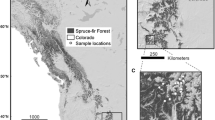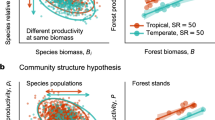Abstract
The response of four northern deciduous tree species to annual climate variation is quantified at two intensively measured sites in northern Michigan, USA. Response to changes in temperature and moisture differ with the species and is dependent on other site conditions. Relationships identified in these field studies indicate that projected climate changes may have dramatic effects on the productivity of at least some commercially important tree species in the northern United States.
Similar content being viewed by others
References
Albert DA, Denton SR, Barnes BV (1986) Regional landscape ecosystems of Michigan. School of Natural Resources, University of Michigan, Ann Arbor
Bernier B, Brazeau M (1988) Foliar nutrient status in relation to sugar maple dieback and decline in the Quebec Appalachians. Can J For Res 18:754–761
Botkin DB, Nisbet RA, Reynales TE (1989) The effects of climate change on the forests of the Great Lakes states. Bull Ecol Soc Am 69:77
Cannell MGR (1985) Dry matter partitioning in tree crops. In: Cannell MGR, Jackson JE (eds) Attributes of trees as crop plants. Institute of Terrestrial Ecology, Great Britain, pp 160–195
Carter KK (1991) An examination of the effects of climate on tree growth in multi-location provenance tests. In: Emerging issues in Northern hardwood management: Air pollution, climate change, and biodiversity. School of Forestry and Wood Products, Michigan Technological University. Ford Forestry Center Publication No 91-1, p 40
Cattelino PJ, Becker CA, Fuller LG (1986) Construction and installation of homemade dendrometer bands. North J Appl For 3:73–75
Coffman MS, Alyanak E, Kotar J, Ferris JE (1983) Field guide, habitat classification system for the Upper Peninsula of Michigan and northeastern Wisconsin. Cooperative for Research on Forest Soils, Department of Forestry, Michigan Technological University. Houghton, p 144
Crow TR (1978) Biomass and production in three contiguous forests in Northern Wisconsin. Ecology 59:265–273
Davis MG (1989) Insights from paleoecology on global change. Bull Ecol Soc Am 70:222–228
Fritts HC (1976) Tree rings and climate. Academic Press, New York
Fryer JH, Ledig FT (1972) Microevolution of the photosynthetic temperature optimum in relation to the elevational complex gradient. Can J Bot 50:1231–1235
Fuller LG, Reed DD, Holmes MJ (1987) Modeling northern hardwoos diameter growth using weekly climatic factors in northern Michigan. In: Forest growth modeling and prediction, vol I. USDA Forest Service, General Technical Report NC-120, pp 467–474
Gale MR, Grigal DF (1987) Vertical root distributions of northern tree species in relation to successional status. Can J For Res 17:829–834
Holdaway MR (1987) The relationship between tree diameter growth and climate in the Lake States. In: Forest growth modeling and prediction, vol I. USDA Forest Service, General Technical Report NC-120, pp 490–497
Holdaway MR, Brand GJ (1985) Identifying climatic variation in growth model errors. In: Influences on tree and stand increment. Maine Agricultural Experiment Station, University of Maine, Bangor. Miscellaneous Publication 631, pp 98–107
Intergovernmental Panel on Climate Change (1990) Scientific assessment of climate change. World Meteorological Organization, United Nations Environment Programme, Geneva, Switzerland
Klock GO, Cline RG, Swanston DN (1984) Geology and soils. In: Wenger KF (ed) Forestry handbook, 2nd edn. J Wiley, New York, pp 65–96
Kramer PJ (1983) Water relations of plants. Academic Press, New York
Kramer PJ, Kozlowski TT (1979) Physiology of woody plants. Academic Press, New York
Langlet O (1963) Patterns and terms of intra-specific ecological variability. Nature 200:347–348
Levitt J (1980) Responses of plants to environmental stresses, vol I, 2nd edn. Academic Press, New York, p 497
Lyford WH, Wilson BF (1966) Development of the root system ofAcer rubrum, L. Harvard University, Harvard Forest Paper No 10
Manabe S, Wetherald R (1986) Reduction in summer soil wetness induced by an increase in atmospheric carbon dioxide. Science 232:626–628
Marty TL, Guries RP, Mohn CA, Wright J (1983) Fifteen-year results of a balsam fir provenance test in the Lake States. In: Proceedings of the Third North Central Tree Improvement Conference. North Central Tree Improvement Association, Department of Forestry, University of Wisconsin, Madison, pp 14–23
Mroz GD, et al. (1984) Annual report of the herbaceous plant cover and tree studies. In: Compilation of the 1984 annual reports of the Navy ELF Communications System Ecological Monitoring Program, vol I. Illinois Institute of Technology Research Institute, Chicago, Technical Report No E06549-17, pp 1–213
Mroz GD, et al. (1986) Annual report of the herbaceous plant cover and tree studies. In: Compilation of the 1986 annual reports of the Navy ELF Communications System Ecological Monitoring Program, vol I. Illinois Institute of Technology Research Institute, Chicago, Technical Report No E06549-38, pp 1–215
Mroz GD, et al. (1987) Annual report of the herbaceous plant cover and tree studies. In: Compilation of the 1987 annual reports of the Navy ELF Communications System Ecological Monitoring Program, vol I. Illinois Institute of Technology Research Institute, Chicago, Technical Report No E06595-2, pp 1–316
Perry TO (1962) Racial variation in the day and night requirements of red maple and loblolly pine. Forest Sci 8:336–344
Pollard DFW (1970) Leaf area development on different shoot types in a young aspen stand and its effect upon production. Can J Bot 48:1801–1804
Schneider SH (1989) The greenhouse effect: science and policy. Science 243:771–781
Shetron SG (1972) Forest site productivity among soil taxonomic units in northern Lower Michigan. Soil Sci Soc Am Proc 36:358–363
Smith DM (1985) The practice of silviculture, 8th edn. J Wiley, New York, p 527
Solomon AM, West DC (1987) Simulating forest responses to expected climate change in eastern North America: applications to decision-making in the forest industry. In: The greenhouse effect, climate change, and US forests. The Conservation Foundation, Washington, DC, pp 189–207
Spurr SH, Barnes BV (1980) Forest ecology, 3rd edn. J Wiley, New York, p 687
Steel RGD, Torrie JH (1960) Principles and procedures of statistics. McGraw-Hill, New York, p 481
Townsend AM, Harvey WR (1983) Genetic analyses for height and diameter growth of 9-year-old red maple progenies in five plantations. In: Proceedings of the Third North Central Tree Improvement Conference. North Central Tree Improvement Association, Department of Forestry, University of Wisconsin, Madison, pp 1–13
USDA Soil Conservation Service (1975) Soil taxonomy. Agric Handbook 436, US Government Printing Office, Washington, DC
Wilson BF (1966) Development of the shoot system ofAcer rubrum. Harvard University, Harvard Forest Paper No 14
Zeide B (1980) Ranking of forest growth factors. Environm Exp Bot 20:421–427
Author information
Authors and Affiliations
Rights and permissions
About this article
Cite this article
Reed, D.D., Jones, E.A., Liechty, H.O. et al. Impacts of annual weather conditions on forest productivity. Int J Biometeorol 36, 51–57 (1992). https://doi.org/10.1007/BF01208735
Received:
Revised:
Accepted:
Issue Date:
DOI: https://doi.org/10.1007/BF01208735




